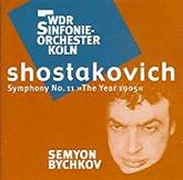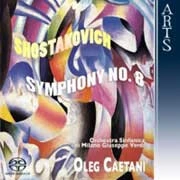Written upon the occasion of the Soviet Union's fortieth anniversary, the Eleventh Symphony of Dmitri Shostakovich "officially" commemorated the peasant protests of 1905 - and the bloody massacre with which Tsar Nicholas responded. The music itself, however, suggests Shostakovich had a more daring "program" in mind: the Soviet Union's ruthless military suppression of the Hungarian uprising the year before. It is arguably Shostakovich's most explicit, emotional and daring indictment of the Soviet state and the totalitarian nightmare it had become - a tour-de-force for virtuoso orchestra showing the influences of Modest Mussorgsky and Gustav Mahler, yet built on melodic material from Russian and Bolshevik revolutionary songs.
Semyon Bychkov, who has achieved a reputation as a master interpreter of Shostakovich though his Avie recordings of the Seventh and Eighth Symphonies, leads the WDR Sinfoieorchester Koln in an overpowering performance, captured in demonstration quality, state of the art surround sound.
Musicians:
WDR Sinfonie Orchester Koln
Semyon Bychkov, conductor
Selections:
Dmitri Shostakovich (1906-1975)
Symphony No. 11 in G Minor, op. 103 "The Year 1905"
1. I. Adagio - The Palace Square
2. II. Allegro - 9 January
3. III. Adagio - In Memoriam
4. IV. Allegro non troppo - Tocsin
Total Time: 59:11
Semyon Bychkov, who has achieved a reputation as a master interpreter of Shostakovich though his Avie recordings of the Seventh and Eighth Symphonies, leads the WDR Sinfoieorchester Koln in an overpowering performance, captured in demonstration quality, state of the art surround sound.
Musicians:
WDR Sinfonie Orchester Koln
Semyon Bychkov, conductor
Selections:
Dmitri Shostakovich (1906-1975)
Symphony No. 11 in G Minor, op. 103 "The Year 1905"
1. I. Adagio - The Palace Square
2. II. Allegro - 9 January
3. III. Adagio - In Memoriam
4. IV. Allegro non troppo - Tocsin
Total Time: 59:11




 Turntable Accessories
Turntable Accessories Headphone Accessories
Headphone Accessories Cable Accessories
Cable Accessories Vinyl Accessories
Vinyl Accessories Compact Disc Accessories
Compact Disc Accessories







